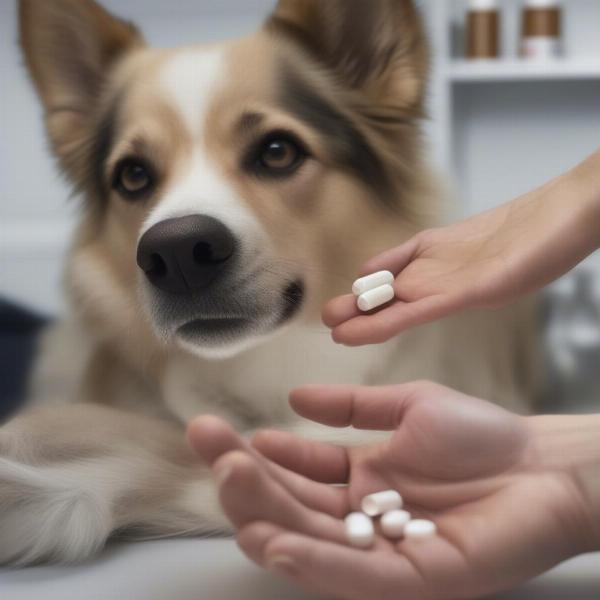Levothyroxine is a commonly prescribed medication for dogs with hypothyroidism, a condition where the thyroid gland doesn’t produce enough hormones. Finding the correct levothyroxine dog dosage is crucial for managing this condition effectively. This article provides a comprehensive guide to understanding levothyroxine dosage in dogs, including factors influencing dosage, potential side effects, and monitoring.
Understanding Levothyroxine in Dogs
Hypothyroidism can cause a range of symptoms in dogs, including weight gain, lethargy, hair loss, and skin problems. Levothyroxine, a synthetic form of the thyroid hormone thyroxine (T4), helps replace the missing hormone and alleviate these symptoms. Administering the right levothyroxine dog dosage is essential to ensure your dog receives the appropriate amount of hormone replacement.
Factors Influencing Levothyroxine Dog Dosage
Several factors can influence the appropriate levothyroxine dosage for your dog. These factors include your dog’s weight, the severity of their hypothyroidism, their individual response to the medication, and any other underlying health conditions. Your veterinarian will conduct thorough blood tests to determine the initial dosage and adjust it over time as needed.
Weight and Severity of Hypothyroidism
Generally, the levothyroxine dog dosage is based on your dog’s weight, with larger dogs requiring a higher dose. The severity of the hypothyroidism also plays a role, as dogs with more severe cases may need a larger initial dose or more frequent adjustments.
Individual Response and Other Health Conditions
Each dog responds to levothyroxine differently, and some dogs may metabolize the medication faster than others. This is why regular monitoring and blood tests are essential. Additionally, pre-existing health conditions like liver or kidney disease can influence how levothyroxine is processed, requiring careful dosage adjustments.
 Dog Receiving Levothyroxine
Dog Receiving Levothyroxine
Administering Levothyroxine to Your Dog
Levothyroxine is typically administered orally, usually twice a day. It’s essential to give the medication on an empty stomach, ideally 30-60 minutes before feeding, as food can interfere with its absorption. Follow your veterinarian’s instructions carefully regarding the timing and frequency of administration.
Monitoring and Side Effects of Levothyroxine
Regular monitoring is crucial to ensure the effectiveness of levothyroxine therapy and to adjust the dosage as needed. Your veterinarian will typically recommend follow-up blood tests 4-8 weeks after starting treatment and then periodically thereafter. While levothyroxine is generally safe, potential side effects can include increased thirst, increased urination, panting, restlessness, and loss of appetite. If you notice any of these signs, contact your veterinarian immediately.
What if I Miss a Dose?
If you miss a dose, give it as soon as you remember. However, if it’s close to the time for the next dose, skip the missed dose and continue with the regular schedule. Do not give a double dose.
Conclusion
Finding the appropriate levothyroxine dog dosage is crucial for effectively managing hypothyroidism and improving your dog’s quality of life. Close collaboration with your veterinarian, regular monitoring, and careful administration are essential for successful treatment. By following your veterinarian’s guidance and observing your dog for any changes, you can help your furry friend live a comfortable and healthy life.
FAQ
- How long does it take for levothyroxine to work in dogs? Typically, you’ll start to see improvements in your dog’s symptoms within a few weeks of starting treatment.
- Can levothyroxine be given with food? No, levothyroxine is best absorbed on an empty stomach. Give it 30-60 minutes before feeding.
- What are the signs of levothyroxine overdose in dogs? Signs of overdose can include increased heart rate, restlessness, panting, and vomiting. Contact your veterinarian immediately if you suspect an overdose.
- Are there any long-term effects of levothyroxine in dogs? With proper monitoring and dosage adjustments, levothyroxine is generally safe for long-term use.
- Can I stop giving levothyroxine to my dog once their symptoms improve? No, hypothyroidism is a lifelong condition. Stopping treatment can cause the symptoms to return.
- What should I do if my dog experiences side effects from levothyroxine? Contact your veterinarian immediately to discuss adjusting the dosage or exploring alternative treatment options.
- Where can I purchase levothyroxine for my dog? Levothyroxine requires a prescription from your veterinarian.
Related Articles on ILM Dog
About ILM Dog
ILM Dog is your trusted global resource for expert advice on dog breeds, health, training, nutrition, and more. We offer practical guidance for all dog owners, from choosing the right breed to providing optimal care. Whether you’re a seasoned owner or just starting your journey with a furry friend, ILM Dog provides you with the information you need. Contact us at [email protected] or +44 20-3965-8624 to learn more.